
It’s a balancing act between tradition and modernity. The Pappert Bakery in the Rhön district in Germany relies on a mix of artisan work and automation in its production operations. These have taken the company on the road to success.
Bernd Pappert and Manfred Klüber, Managing Directors of the Pappert family business, could be pleased at the opening of their 107th specialist shop in late 2017. The bakery wants to grow further in 2018 as well. The sales region in this respect extends to a radius of about 100 km around Fulda in the states of Hesse and Bavaria, northwards as far as Philippsthal and Obersuhl, westwards to the RheinMain district and southwards to Schweinfurt and Würzburg. A total of 1,300 employees work to ensure the company’s success. The bakery’s headquarters in Poppenhausen is only a few kilometers from Fulda. Around 130 staff work in the production area, with a daily output of up to 12,000 breads, 200,000 bread rolls and 45,000 pieces of small baked goods. Work takes place in two shifts, seven days a week. Master Baker Martin Schiller, who shares responsibility for the production operation, explains that “Snacks and bread rolls in particular are growing at the moment.” Schiller views the bread and rolls areas among the bakery’s core competences.
To raise production capacity and increase the quality of the small baked products, the bakery recently invested in a new Crusto bread/bread roll plant from the Dutch plant constructor Rademaker. The medium-sized bakery’s requirements for this were high. For example, on the one hand there is a need to systematically reduce the use of baking agents, and on the other the new line must process doughs with a higher dough yield and longer dough resting time. The plant must also be flexible at the same time, e.g. to allow the production of new baked product shapes such as diamonds.

Production Manager Martin Schiller (r.) and Ewald Kümmel, Sales/Distribution for Rademaker Deutschland GmbH
Special features
Martin Schiller adds “We had some more requirements for the plant constructor.” As a result of the bakery’s organic growth, the baking area had also expanded continuously due to various additional structures and expansions. It was therefore necessary for the Crusto bread/bread roll plant to be integrated into the bakery’s new extension building during ongoing production. Master Baker Schiller says “With a total plant length of only 20 meters, there was also a requirement to include manual workstations to give the baked products an individual artisan touch.” A challenge for plant constructor Rademaker. The solution is a Crusto bread/bread roll plant that produces a dough sheet gently by using a stress-free Double Chunker system (DSS). Ewald Kümmel, responsible for Sales and Marketing in Rademaker Deutschland GmbH, explains that “The system represents the gentlest possible dough handling. This is especially important when processing doughs with very long dough resting times and a high TA (Dough Yield).”
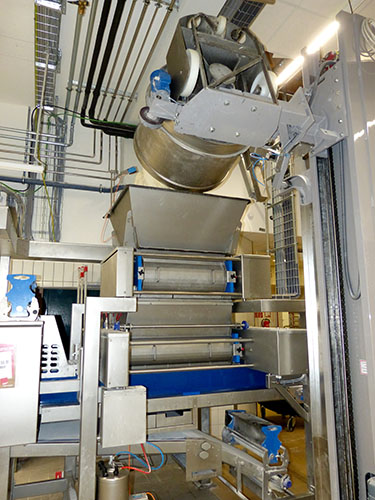
The start of the Crusto bread/bread roll plant, with a Double Chunker stress-free system to gently produce the dough strand
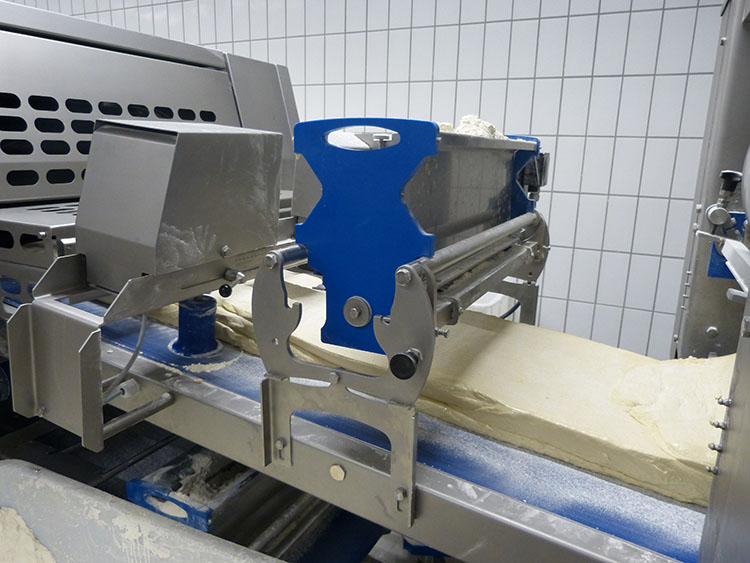
The dough pieces of the dough strand overlap one another, as can be seen at the start of the line
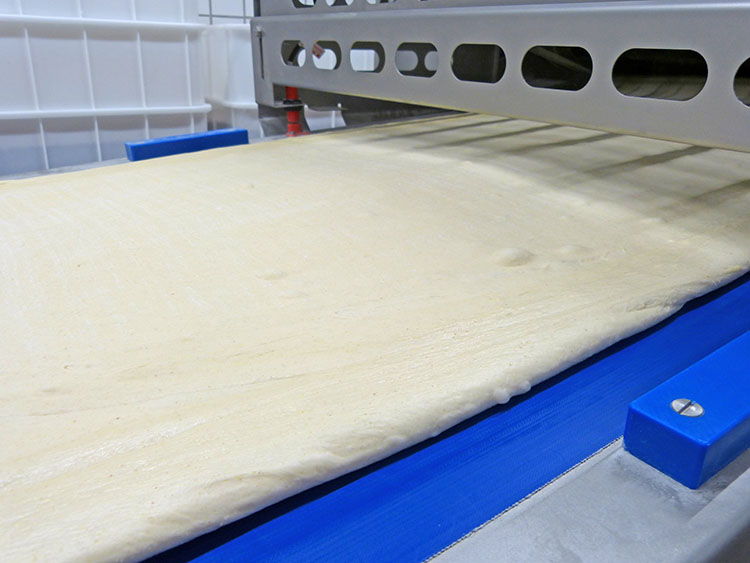
A quick reducer, cross roller and finishing station gently shape the dough sheet to the required dough sheet thickness. Fermentation bubbles are still visible in the dough
Mode of operation
First of all, a bowl tipper loads the dough into the line’s dough cones at the start of the line. From here, the dough is transferred in a gentle, controlled way into a second, lower and slightly oiled cone. Next the system uses a double star roller to portion out dough pieces each weighing 20 to 25 kg. The dough pieces then go onto a flour-dusted conveyor belt whose plastic limiters at the sides ensure the formation of a continuous dough strand. In this operation, the dough pieces from the DDS are deposited in such a way that they have a 50% overlap.
This is followed by a first roller to reduce the dough thickness, and the dough strand is transferred to another flour-dusted conveyor belt. This belt is positioned under the DDS unit. A continuous dough sheet is formed, on which the transitions between the individual overlapping dough pieces are still easily visible after the first finishing station, because the dough sheet is rolled out and reduced very gently. Further finishing stations and a cross roller unit ensure that the dough sheet is rolled out to the required thickness, e.g. 15 mm. Various flour dusters that are manually refilled by employees are installed to enable the reduction.
Production Manager Schiller explains that the new plant allowed an immediate three points increase in dough yield. It is also possible to achieve the desired open pore pattern for certain products like ciabatta. The plant also has a working width of 600 and 800 mm respectively (dough sheet production 600 mm / dough sheet make-up 800 mm). Hourly output capacity ranges from approx. 500 kg/h to approx. 1,500 kg/h. This corresponds to approx. 6,000 to 18,000 bread rolls per hour, depending on the dough and weight range.
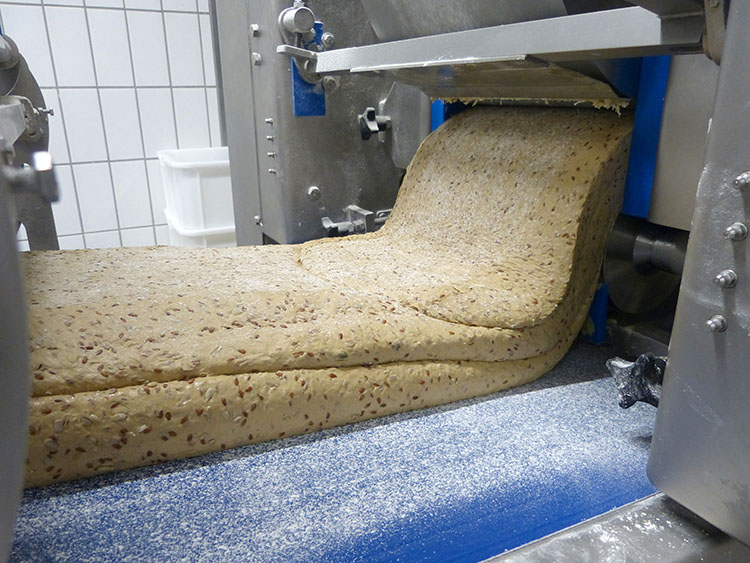


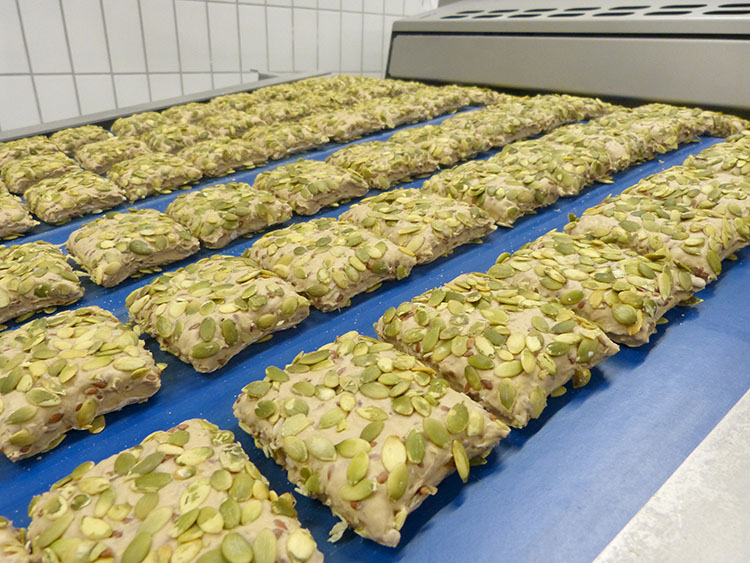
Same plant, different dough. Here again, the way the dough pieces overlap is clearly apparent. The dough sheet after rolling out and ready for strewing with pumpkin seeds. The top surface is strewn in the first step. Longitudinal cutting and spreading the dough sheets apart occur next, followed by the bottom seeder. Finished dough pieces for pumpkin seed bread rolls
Hygiene
The line is divided into various modules to guarantee the highest possible flexibility. Each of these modules is also moveable and can be removed from the plant, e.g. to wash it. In this respect, the entire machine is laid out on the “Design for Wash-down” principle (D4W), i.e. it can be wet-cleaned without using high pressure. Moreover, to simplify cleaning and drying the plant, all the belts can be loosened quickly and without using tools.
Another special feature is provided by the moistening unit, which operates airlessly and very precisely targeted and efficient, so no water mist is formed either.
Bottom seeder
The dough sheet is cut into the required number of dough strips by longitudinal cutter rollers, and its edges are trimmed. The resulting scrap dough is collected and recycled to the production unit’s trimmings. The continuous dough strips are spread apart to peelboard loading spacing, and fed into the following bottom-seeder/strewer module. Here the dough strips are moistened with water from below by a moistening roller and immediately laid into the strewing material, which is continuously spread over the whole width of a conveyor belt running underneath. An adjustable-height driven roller presses the dough strips gently into the strewing material to assist adhesion. This allows grains, seeds and semolina to be applied to the lower surface of the dough pieces without the need to turn the latter over. This enables a uniform strewing pattern even on triangular bread rolls, diamond-shaped rolls or pierced baguettes. A compact mobile recycling device (air-free) is then used to return excess unattached strewing material to the feed cone. Production Manager Martin Schiller confirms that it’s “a very flexible, hygienic solution.” After the bottom-seeder/strewer module, an electromechanical guillotine uses either a guillotine knife or various punches to pre-portion the dough pieces.
Distribution
The company’s own delivery trucks (six HGVs and fifteen box vans) supply branches with baked goods up to twice daily. The employees freshly bake dough pieces in instore ovens on the spot. The Pappert bakery focuses on its own sales outlets and less on the supply business. The sales outlets are located within a radius of up to 110 km around the bakery.
The bakery operates various sales concepts as a supplement to its core bakery business:
Pappiamo: Pappiamo represents Italian hospitality and supplies customers with pizza and pasta, which are freshly prepared in front of the customers.
zuTisch: zuTisch (“lunch is ready”) is Pappert’s fast food concept (not just at midday). It allows customers to put together their lunchtime meal from various modules on the building block principle.
Giovanni L.: Giovanni Lasagna stands for a very special kind of ice cream creations. Using the best raw materials and highest quality ice cream, entirely in the Lasagna family’s traditional style.
Zweittag (day two): The previous day shop for baked goods returns and surpluses is a solution combining a baked products counter and on-the-spot consumption.
Universal strewing devices
Strewing the upper surface is carried out upstream of the finishing station, using a universal strewing device that rolls the grains into the upper surface. Martin Schiller explains that “The combination of the universal strewing device and the bottom-seeder/strewer module enables creative strewing combinations to be achieved on the upper and lower surfaces, and it has also allowed a reduction in the loss of strewing material over the whole process.” An adjustable-height flipping edge allows the dough pieces to be turned flexibly depending on whether they are to be deposited onto peelboards (and are turned again before baking on trays) or directly onto the baking trays.
A depositor belt and retraction movement deposit the dough pieces onto either two proofing peelboards (600 x 400 mm) or one baking tray (580 x 780 mm). For this, the peelboards are automatically unstacked from a peelboard magazine and cycled under the depositor. The peelboards magazine for the plant was also built by Rademaker, and is refilled by hand.
Before the peelboards are removed and stacked, the Rademaker line also includes a manual work track where employees can give the dough pieces an additional special individual shape.
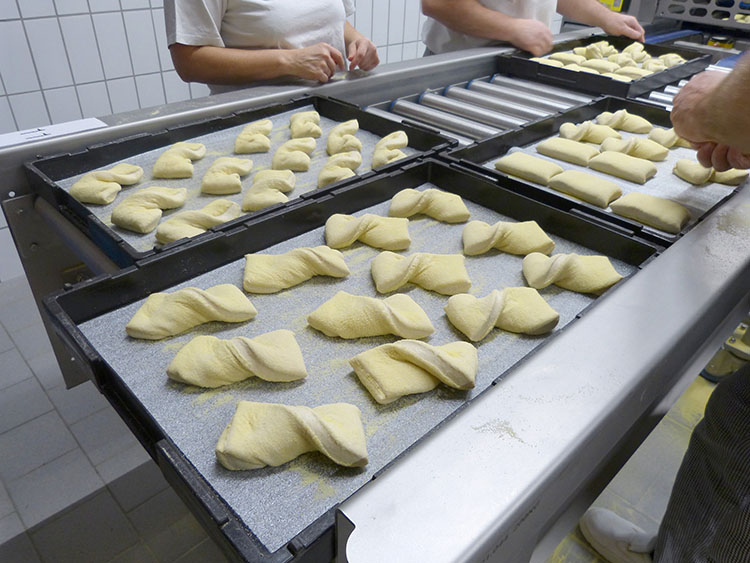
The total length of the new plant is around 20 meters. Employees can give baked products an individual finishing touch at integrated manual workstations
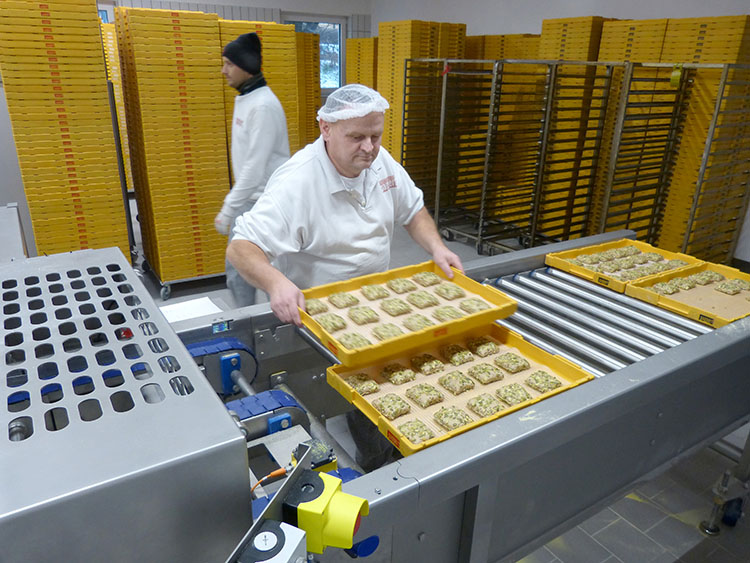
An employee removes the peelboards and stacks them. The peelboards magazine for the plant was also built by Rademaker, and is refilled by hand.
Tool changeover
All the product-related tools, cutting knives, molding punches etc. are kept ready on a generously-sized tool trolley for quick product changeover. Production Manager Schiller explains that “It takes us about 10 minutes to carry out a product changeover.” Production using the new plant is now altogether more uniform, i.e. the quality of the baked products is homogeneous, there is less wastage, and the strewing pattern is more uniform. The plant’s output performance limit has not yet been reached, so the bakery still has capacity, e.g. to pre-produce dough pieces. Using the new line does away with a total of three intermediate steps compared to the previous production method. This has increased performance while reducing personnel deployment at the same time. Schiller says “Pressure on the staff has been significantly reduced, and we have also been able to improve working conditions.”
Dough pieces deposited onto peelboards are baked off by the staff in the sales outlets. Each branch has one or more Miwe or Debag instore ovens for this purpose. The total number of peelboards in circulation is around 30,000.
Investment
Pappert’s new plant cannot produce split-top rolls. According to Kümmel: “In general, this is possible by installing a corresponding module, but there was simply no more space for it in the enlarged production unit.” So in the future Martin Schiller wants to invest in a new, compact split-top roll plant with a peelboard connection. The master baker could also imagine using robots in the production operation, e.g. to automatically stack loaded peelboards.
The growth limits of the Poppenhausen site have now been reached with the latest expansion of production and logistics. Martin Schiller says “This is why optimized workflows and automated processes on the existing area are top priority. The new Rademaker Crusto special bread roll line has helped us greatly in this respect.”
Pappert goes green
“Pappert goes green” is the bakery’s dynamic idea to work more sustainably. Communications and Marketing Manager Thomas Bertz explains: “We deliberately described the guiding principle as a process, not a finished construct.” This process already contains the following:
+ purpose-made refillable, reusable beakers
+ purpose-made cotton bags
+ a 20 Cent price discount for anyone who uses a reusable beaker to buy a hot drink
+ Avoiding the use of plastic carrier bags. Paper carrier bags instead
+ the to-go beakers are compostable


